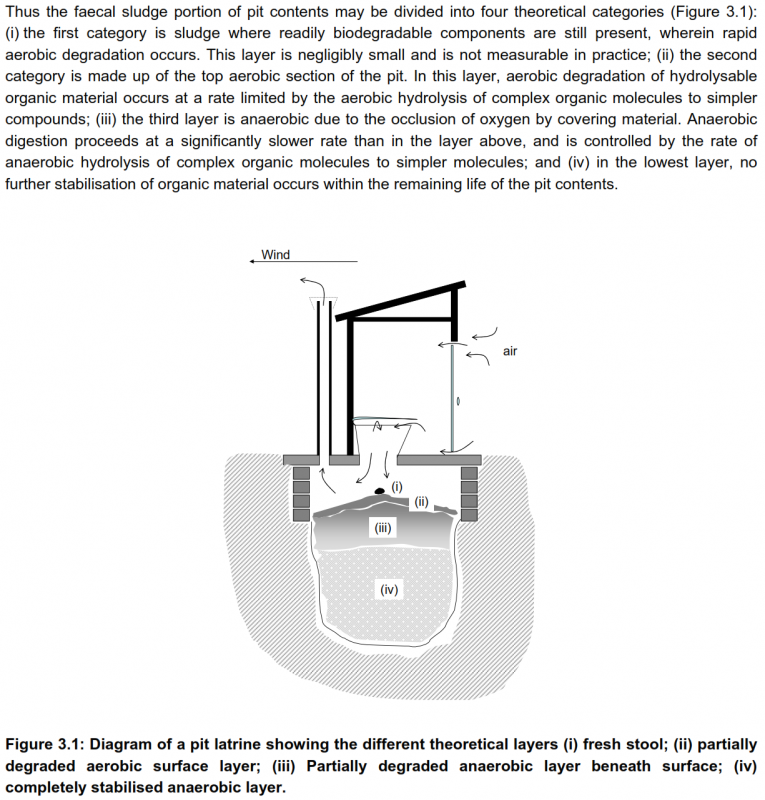- Sanitation systems
- Treatment of wastewater, sludges, organic waste, excreta
- Composting
- Composting of faecal matter with the help of effective microorganisms or other additives?
Composting of faecal matter with the help of effective microorganisms or other additives?
10.2k views
- joeturner
-
 Less
Less- Posts: 717
- Karma: 23
- Likes received: 185
Re: Bokashi and Sanitation? (and effective microorganisms, EM)
One thing I'd say is that fresh grass clippings are not great to use in faecal compost because they typically have quite a high C/N ratio - the best advice is that the overall C/N ratio needs to get to around 30/1 to get efficient composting, so adding more high-N material to the faeces may not help. Ideally one wants to use something known to have a high C/N ratio, such as a woody crop like miscanthus.
A simple calculation of the available oxygen in a pit latrine (and more in a composting toilet or other small space) shows that there will be a limit to aerobic microbial activity, leading to negligible aerobic growth, and little competition with the pathogenic microbes. Adding extra microbes in that situation is going to do nothing at all about the oxygen or carbon status.
Composting in large outdoor windrows where there is a lot of air is a different thing. There it is possible to get away with using less desirable high C/N ratio materials (with sufficient compost turning) - but the result may well be high be releases of ammonia and sulphorous gases, leading to odours and maybe even bioaerosols.
In that situation I can believe that it might be possible to have an effect by innoculating specific microbes, but I still do not believe that the majority of those bokashi preparations on the market have been properly tested to be effective. If one has a large multi-ton windrow, one has to wonder how much difference a small bottle of something is going to make. Even if it did, I agree that it is probably not going to do as much as adding soil or some part-finished compost to the new heap.
The whole problem here is that faecal composting sounds simple but actually involves many variables which may be difficult to measure and control. It is hard to believe that the Chinese could be producing a microbial preparation which could overcome all those variables - but until that is proven that it is possible, I think the best science suggests to avoid spending money on these kinds of preparations.
Please Log in to join the conversation.
You need to login to replyRe: Reply: Bokashi and Sanitation? (and effective microorganisms, EM)
When it comes to pit latrines, ie mainly aged anaerobic partly degraded organic material, volume reduction by adding just microorganisms is not in most cases going to do very much. Anaerobic breakdown is much less efficient than aerobic. The classic work of Chris Buckley et al in 2008 provided new insights into what is really going on in a pit latrine and why additives don't really do very much. See www.wrc.org.za/Knowledge%20Hub%20Documen...ng%20communities.pdf
The following excerpt is particularly insightful and describes the 4 zones in a pit latrine.
With regard to the Chinese use of EMs in composting (not normally added to pit latrines but to aerated composts), there is sophistication in their production in special fermentation labs. The mixtures are kept generally as trade secrets and few specialist professors keep the recipes and labs under lock and key. These mixtures are working mainly under aerobic conditions and they deal with both short and long carbon chains (ie bacteria, yeasts and molds). Even ammonia control is part of this mastery using nitrobacters to produce odorless nitrate. But when it comes down to it most of the EM bugs originate in soil to begin with. That's where all the evolution has taken place.
Stockholm Environment Institute
This email address is being protected from spambots. You need JavaScript enabled to view it.
www.sei.org
www.ecosanres.org
Attachments:
-
 Buckleyetal2008.png
(Filesize: 535KB)
Buckleyetal2008.png
(Filesize: 535KB)
Please Log in to join the conversation.
You need to login to reply- Elisabeth
-
- User is blocked
- Freelance consultant since 2012
Less- Posts: 3372
- Karma: 54
- Likes received: 932
Re: Reply: Bokashi and Sanitation? (and effective microorganisms, EM)
(Urs, as you mentioned faecal transplants, you might be interested in this thread here which we had about faecal transplants: forum.susana.org/forum/categories/26-hea...9-faecal-transplants quote: "As modern science begins to appreciate the critical role gut bacteria plays in human health, his treatment of diseases including Crohn's and colitis, auto immune diseases and even neurological disease is provoking both criticism and excitement.")
Let's get back to the pit additives (and to bokashi-type composting; briefly described here on Wikipedia: en.wikipedia.org/wiki/Compost#Bokashi - no idea if it's an accurate description).
Arno: you mentioned research at the Uni Wageningen. I think that's exactly the research that I quoted above on 16 Feb which states that pit additives don't work, isn't it? Katja Grolle from Uni Wagening made a presentation about it in Hanoi in January which I wrote about here:
forum.susana.org/forum/categories/170-pu...ste-management#11976
Here is what I had written in that post:
++++++
There is also a BMGF project that was investigating pit additives (the second one in this list ) and they have found nothing that works. I actually chaired a session at the FSM3 conference in Hanoi where Katja Grolle from the Netherlands told us about her research which must have been very frustrating because none of the additives that she tested in the lab had any effect. You can see her presentation here:
Laboratory investigations into solids solubilisation of black water and faecal matter: Effect of additives and internal physical chemical pit latrine aspects: Katja Grolle, Department of Environmental Technology and Research, University of Wageningen, Wageningen, The Netherlands
www.susana.org/images/documents/07-cap-d...-3/3-3-2-3Grolle.pdf
Video of her presentation:
She tested a lot of them:
Additive types tested:
2 Soils, 3 inorganic conditioners
4 Commercial bio-additives
6 Enzymes, 1 mix
1 Fungus mix
15 Pure and 5 mixed cultures of microbes
10 Active herbivore dung extracts
+++++++
Unless you are talking about other research at Uni Wageningen that I am not aware of?
By the way, I e-mailed Katja to alert her to this discussion and this is what she replied:
Dear Elisabeth,
Thank you for your mail. I feel as passionate as you about wasting money of the poor by putting trust in products that have no benefit for them.
Regarding the inclusion of bio-additives and their working for sanitation systems in the Wikipedia site about Effective Micro-organisms (EM) I agree with Chris Buckley: it would be better to have a separate site on that subject. From my point of view the text about the working of EM discredits the content of the bio-additive paragraph.
Regarding another reference for the work done by me: you’ll have to wait. I am about to finish 2 articles of this research.
About your other point, Arno, about microbial mixtures to spike compost; this might be a different matter to pit additives. I guess it is about having the right compost microorganisms there to start with. Although normally they also just come from the soil etc. If anything I would buy myself some earthworms if I want to start off with a vermi-composting system?
But if you have documents at hand that describe this process in China and why/how it works, please share them, this could be very interesting.
Regards
Elisabeth
Freelance consultant on environmental and climate projects
Please Log in to join the conversation.
You need to login to reply- SusannahSoilet
-

- Trying to use biology to recycle wastes and preserve soil fertility. Working on the 'Soilet System'
Less- Posts: 17
- Karma: 1
- Likes received: 8
Re: Reply: Bokashi and Sanitation? (and effective microorganisms, EM)
I agree that the most efficacious organisms are about, just not all identified yet.
Could the analogy be drawn with other 'fermentations'? I am currently making Kimchi, kefir and other ferments for the household, and was previously responsible for developing prizewinning dairy products including cheeses, creme fraiche and yogurts - using the correct starter for a recipe is vital! With the vegetable ferments, natural lactobacilli and yeasts on the plant leaves are given the right conditions to thrive (saline, anaerobic) so a starter isn't strictly required.
A latrine 'starter' - similar to bacteria blends that livestock farmers can use to add to slurry stores - could have benefits in proteolysis and cellulose digestion which would slow pit filling time (and make emptying easier). EM has been show to work in anaerobic conditions, and to reduce smells and outcompete pathogens.
Phages as disease control agents (eg cholera) and specific fungi to attack ascaris eggs are both potentially possible. My current research is to improve and direct biological activity of soils and organic amendments.
Susi Batstone Soilet Systems Ltd.
Please Log in to join the conversation.
You need to login to replyRe: Reply: Bokashi and Sanitation? (and effective microorganisms, EM)
EM research has received much attention at Wageningen Univ in Holland. And using the microbial mixtures to spike composts is a big deal in China where companies provide a subscription service to supply on a regular basis seed material to keep systems at optimum. China has some 1500 large scale composting plants that take on sewage sludge and organic wastes to produce fertilizer products.
--Arno
Stockholm Environment Institute
This email address is being protected from spambots. You need JavaScript enabled to view it.
www.sei.org
www.ecosanres.org
Please Log in to join the conversation.
You need to login to reply- barisot
-
Topic AuthorLess
- Posts: 2
- Likes received: 0
Composting of faecal matter with the help of effective microorganisms or other additives?
In a recently held open course on the gut microbiome (it was announced in the forum, thanks) researchers are dealing with similar difficulties. e.g. it seems that the only efficient treatment of methicillin-resistant Staphylococcus aureus (MRSA) is a small faecal infusion taken from a healthy person - as well an insignificant number of microbes. Or it is still impossible to define a standard of a healthy gut microbiome because there are big variations among healthy individuals.
Similar effects we can observe in the "human social ecosystem". e.g. under certain conditions it is possible for a single person to mesmerize a crowd or if the conditions are right a person can pass a message over a large distance with overtone singing.
I still think we could find microbes or fungus which participate in a volume reduction of the pit material.
Best, Urs
Please Log in to join the conversation.
You need to login to reply- Sanitation systems
- Treatment of wastewater, sludges, organic waste, excreta
- Composting
- Composting of faecal matter with the help of effective microorganisms or other additives?







